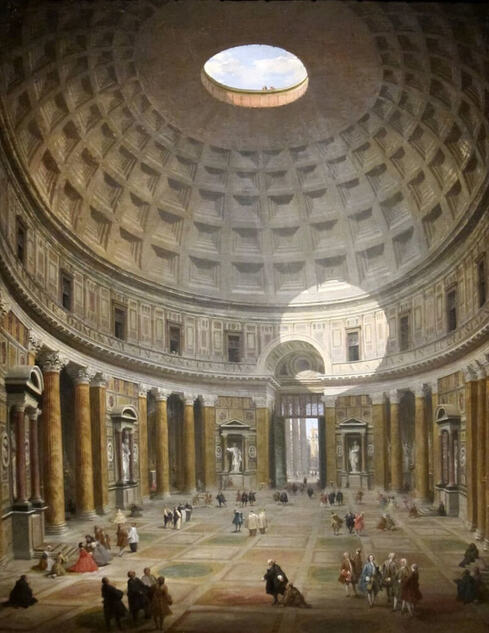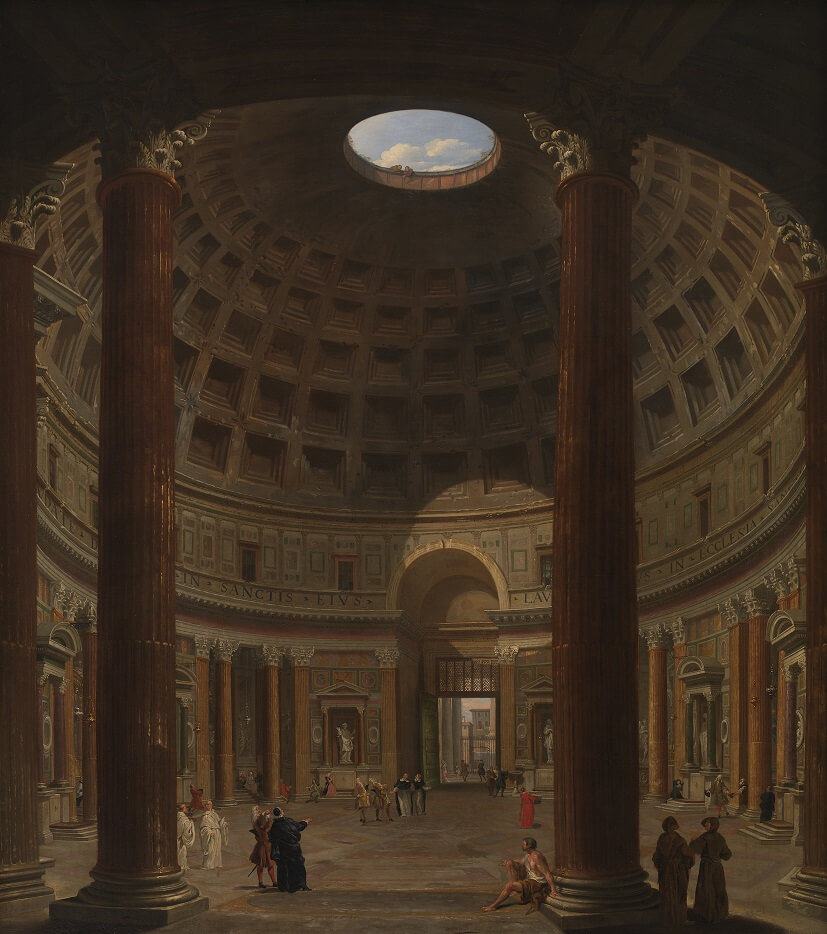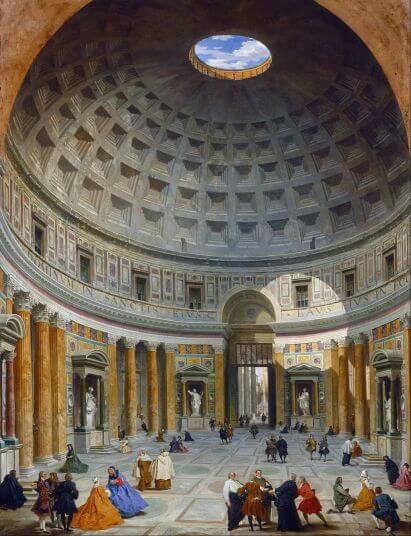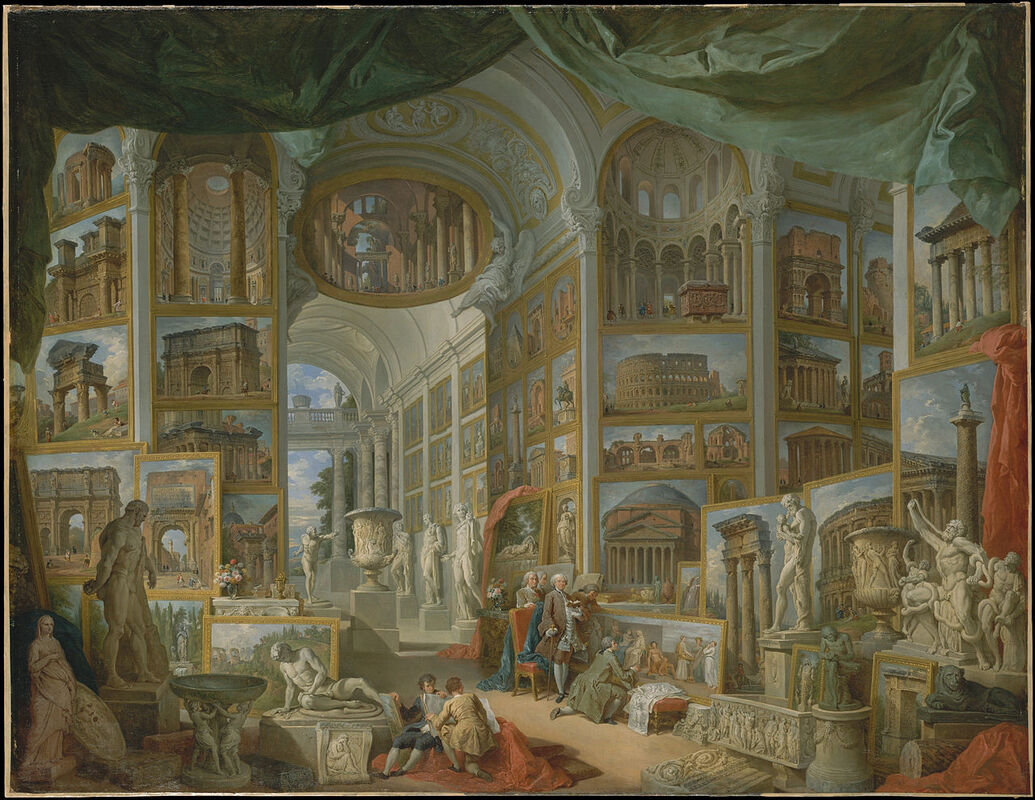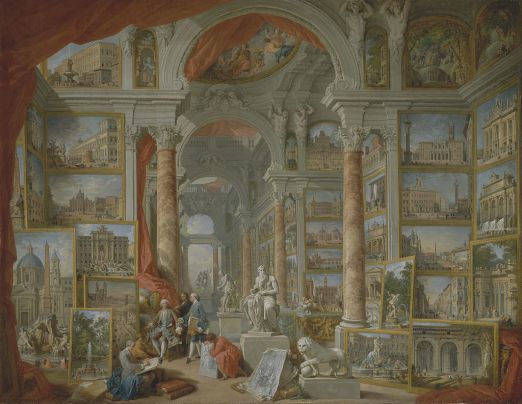|
Where? Gallery 217 of the Cleveland Museum of Art
When? 1747 Commissioned by? Possibly by William Drake after he completed a tour through Italy in 1745. What do you see? Around 60 people are inside the Pantheon. They are engaged in different activities like admiring the architecture, talking, and praying. The group in the right foreground may contain the commissioner of the painting, but this is not certain. The visitors look small compared to the size of the building. Most people stand or kneel in the open space in the middle. Enormous Corinthian columns and statues surround this space. In the middle background is the entrance to the Pantheon and we can identify the Egyptian obelisk in the Piazza della Rotonda in front of the Pantheon. The dome is decorated with sunken square panels (called a coffered ceiling). The light enters through the opening in the dome. You can see the sunlight just to the right of the entrance to the Pantheon. The floor is decorated with squares and circles which are also used to decorate the walls. Backstory: The view in this painting is not entirely realistic. While Panini accurately painted the Pantheon, the painting shows more than is possible from a single place in the Pantheon. Since 609 AD, the Pantheon is a Christian church and quite some modifications to the Pantheon have been made over time. As a result, the view that Panini painted is not the same as what you see today when visiting the Pantheon. For example, the bottom of the dome contains some inscriptions.
Different versions of this painting: Panini created several other versions of this painting. At least eight versions are known of which four are on public display and the others are in private collections. All versions are somewhat different from each other. The versions on public display can be divided into two types.
History of the Pantheon? The Pantheon was built between 113 and 126 AD, during the reign of the Roman Emperor Hadrian. It was built on the spot of a burnt-down Roman temple built by Agrippa between 29 and 19 BC. Pantheon literally means ‘all gods’ and was dedicated to every Roman God. However, in 609 AD the Pantheon became a Catholic church. The Pantheon is also called Church of St. Mary and the Martyrs and every week at least two masses are held inside.
The height of the dome and the diameter of the dome are the same, 142 feet (43 meters). The diameter of the opening on the top is 27 feet (8 meters). Quite some famous people, including kings and artists, are buried in the Pantheon, including Raphael. Who is Panini? Giovanni Paolo Panini was born in 1691 in Piacenza, Italy, and died in Rome in 1765. He was a painter and architect, but also produced fireworks. He was the best-known painter of veduta, which are detailed and factually correct paintings of city views or buildings. He was popular among tourists for his paintings with views of Rome and some of the most impressive buildings in Rome. As photography did not exist yet in the 17th century, tourists asked Panini to draw some of the major sights as a memory to their trip. Two of his most famous paintings are Ancient Rome (with versions in the Louvre, Metropolitan Museum of Art, and the Staatsgalerie in Stuttgart) and Modern Rome (with versions in the Louvre, Metropolitan Museum of Art, and the Museum of Fine Arts).
Fun fact: The opening on top of the dome is called the oculus. This was a common design feature in Roman and Byzantine art. Most importantly, it allows light to enter the building. In addition, it allows rain to enter, which helped to cool down the interior of the building during the Summer months.
In the current version of this painting, Panini painted two people on the edge of the oculus, peering into the Pantheon. This was a small joke by Panini as in reality people would not be able to get on top of the dome. Interested in a copy for yourself? Poster or canvas of the slightly different version in the National Gallery of Art.
Written by Eelco Kappe
References:
0 Comments
Leave a Reply. |
Categories
All
|
- Home
- Blog
-
Museums
- Alte Pinakothek
- Art Institute of Chicago
- Baltimore Museum of Art
- Barber Institute of Fine Arts
- Bargello
- Barnes Foundation
- British Museum
- Church of Sant’Anastasia
- Cleveland Museum of Art
- Courtauld Institute of Art
- Detroit Institute of Arts
- Frans Hals Museum
- Galleria Borghese
- Gallerie dell'Accademia
- Getty Museum
- Guggenheim
- Hermitage Museum
- Kunsthistorisches Museum
- Kunstmuseum Basel
- Legion of Honor Museum
- Louvre
- Mauritshuis
- Metropolitan Museum of Art
- Musee d’Orsay
- Museum of Fine Arts in Boston
- Museum of Modern Art
- National Gallery in London
- National Gallery of Art
- National Museum in Poznań
- Norton Simon Museum
- Ny Carlsberg Glyptotek
- Palace of Versailles
- Palazzo Pitti
- Palazzo Vecchio
- Petit Palais
- Philadelphia Museum of Art
- Prado
- Pushkin Museum
- Ravenna Art Museum
- Rijksmuseum
- San Diego Museum of Art
- Santa Maria delle Grazie
- St. Peter's Basilica
- Städel Museum
- Statens Museum for Kunst
- Tate Britain
- Tate Modern
- Timken Museum of Art
- Uffizi
- Vatican Museums
- Wallace Collection
-
Artists
- Altdorfer
- Anguissola
- Berlin Painter
- Bosch
- Botticelli
- Boucher
- Bronzino
- Bruegel the Elder
- Brunelleschi
- Cabanel
- Caillebotte
- Canova
- Caravaggio
- Carpeaux
- Cezanne
- Cimabue
- David
- Degas
- Delacroix
- De Maria
- Donatello
- El Greco
- Fontana
- Fra Angelico
- Fragonard
- Gauguin
- Gentileschi
- Gericault
- Gonzalez-Torres
- Goya
- Hals
- Hogarth
- Hokusai
- Ingres
- Leonardo da Vinci
- Lippi, Filippo
- Longhi, Barbara
- Lorrain
- Makovsky
- Manet
- Massys
- Matisse
- Merian
- Michelangelo
- Mochi
- Modigliani
- Monet
- Panini
- Parmigianino
- Perugino
- Picasso
- Pisanello
- Raphael
- Rembrandt
- Renoir
- Reynolds
- Rivera
- Rodin
- Rubens
- Scultori
- Seurat
- Steen
- Tintoretto
- Titian
- Toulouse-Lautrec
- Turner
- Uccello
- Van der Weyden
- Van Dyck
- Van Eyck
- Van Gogh
- Van Hemessen
- Vasari
- Velazquez
- Vermeer
- Veronese
- Vigée Le Brun
-
Locations
- Books
- About Us

